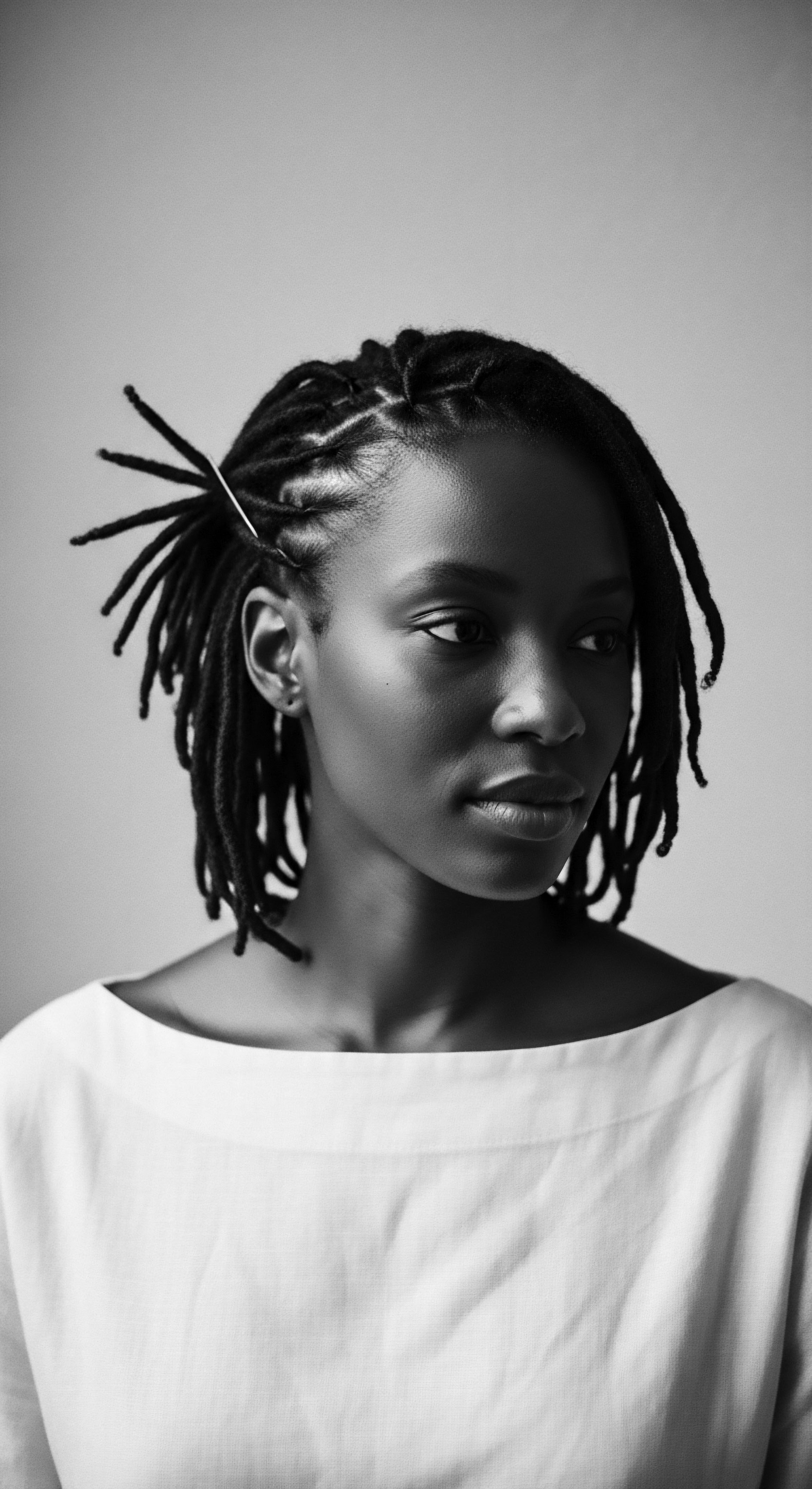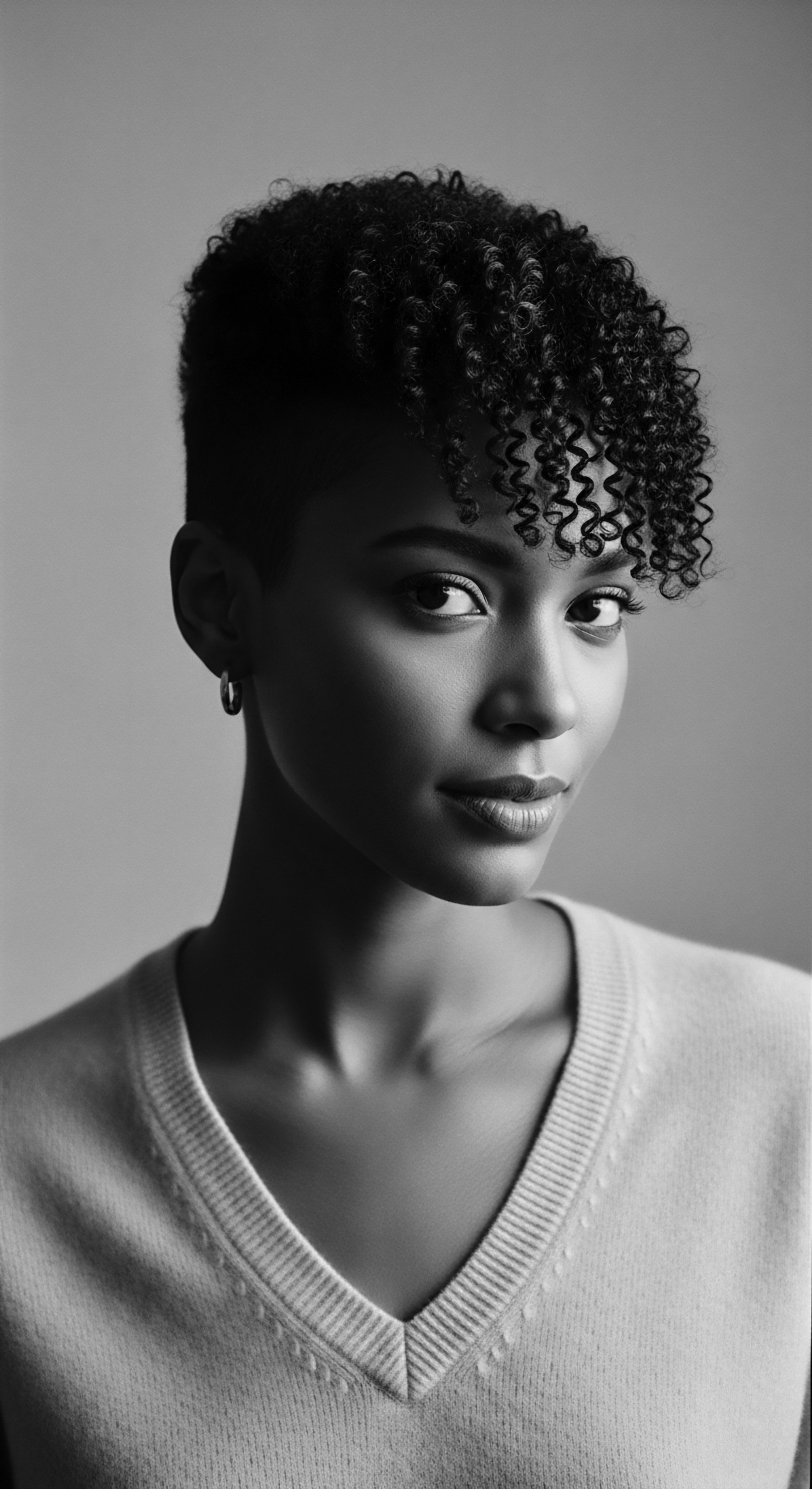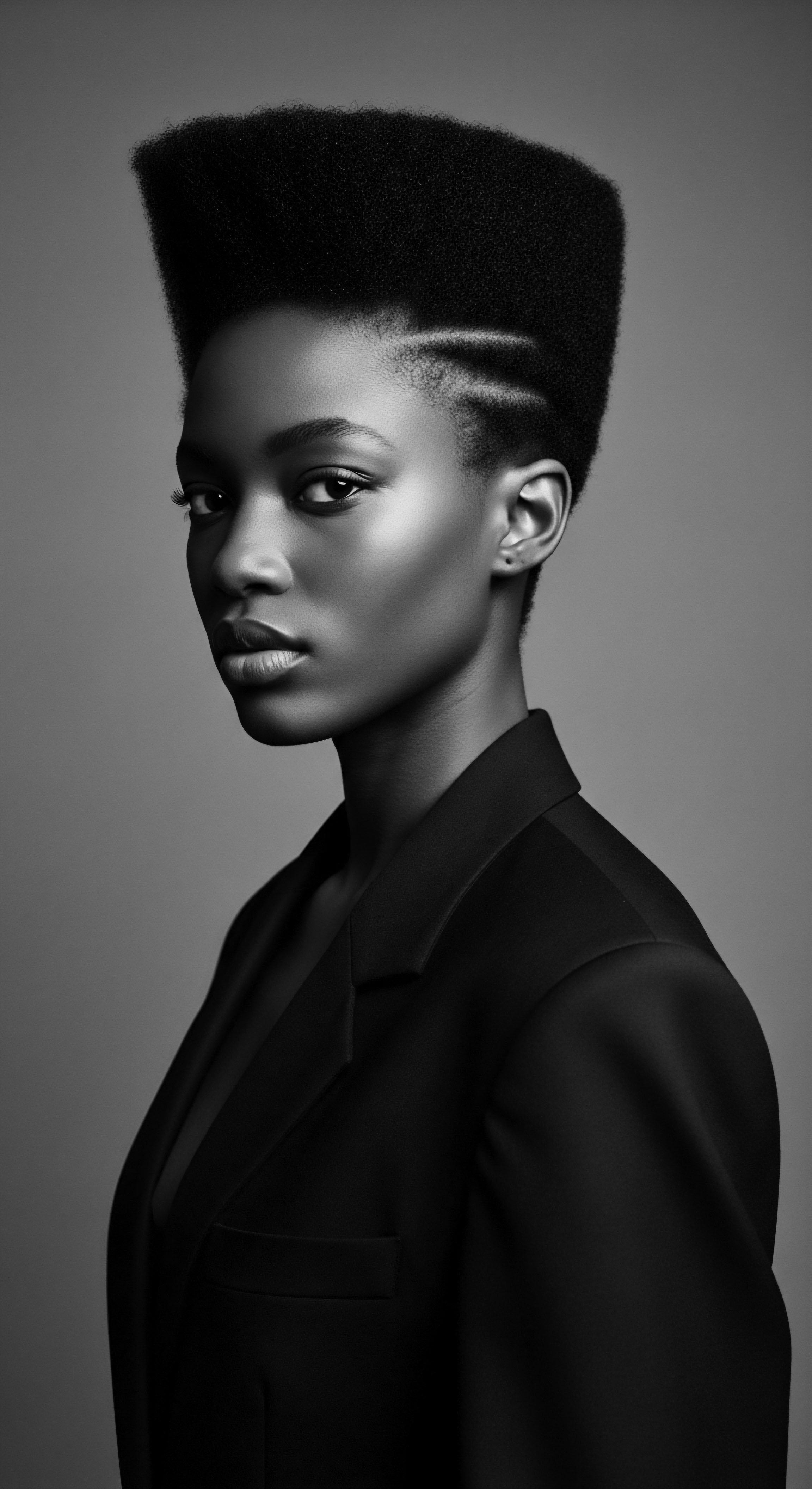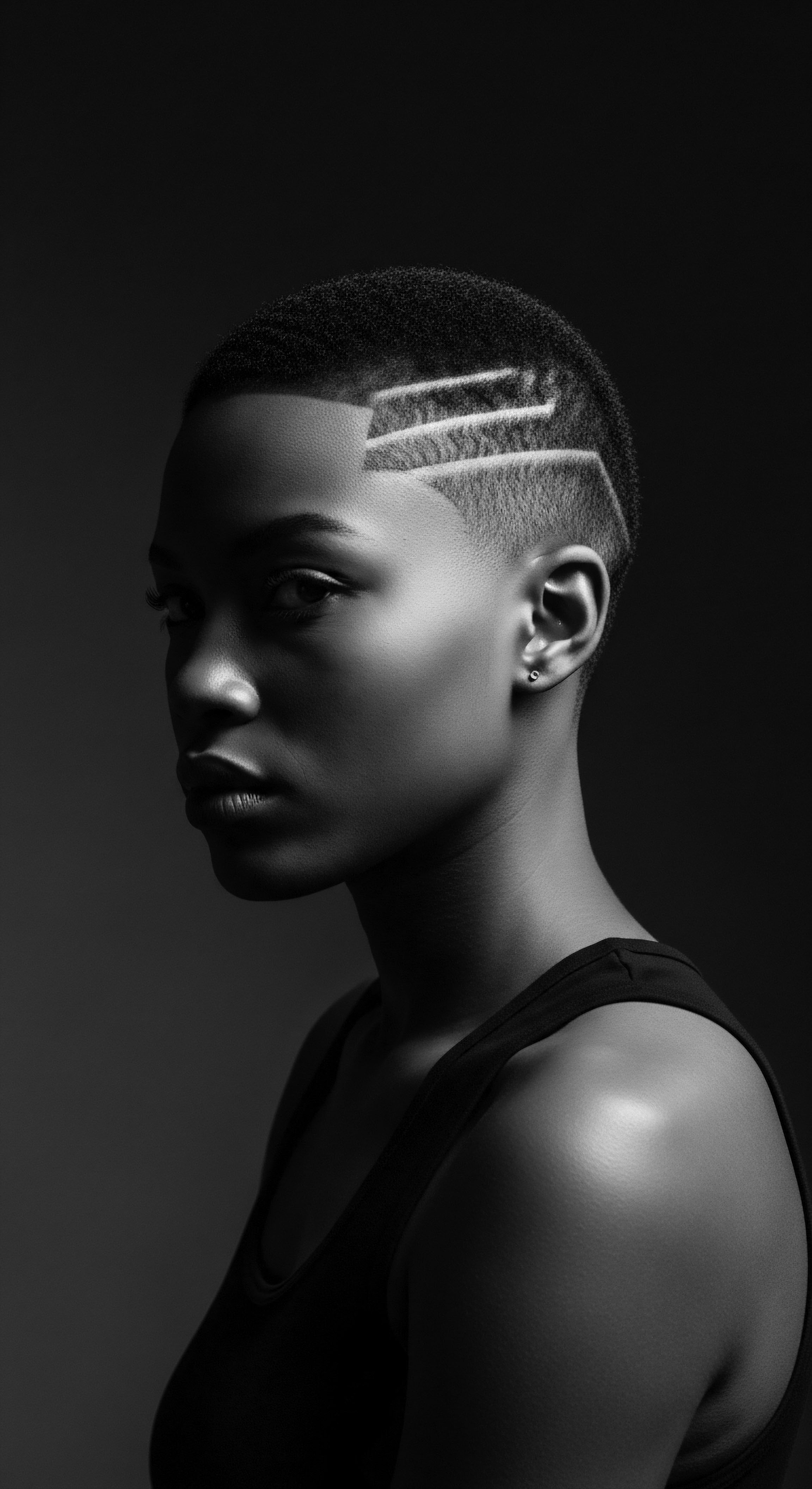The deep rhythms of textured hair speak a language woven through generations, a testament to resilience and beauty. For too long, the stories held within each coil and curl, stories of ancestral care and vibrant cultural identity, have been overlooked in the broader scientific conversation. Yet, when we consider the profound wisdom passed down through African communities, particularly regarding their rich pharmacopoeia of botanicals, a question arises with an undeniable call ❉ Can traditional African botanicals offer new scientific understanding for textured hair?
This is not a simple query about ancient remedies. It is an invitation to acknowledge a living, breathing archive of knowledge, asking what the plant life of Africa, so deeply intertwined with hair heritage, might reveal to contemporary science about textured hair’s intricate biology and its optimal care.

Roots
The journey into understanding textured hair begins at its very source, within the biological architecture that gives each strand its unique character. For millennia, various African societies understood this intricate structure, not through microscopes, but through observation, intuition, and the remarkable results of their care practices. This ancestral wisdom, passed from elder to youth, from hand to coil, forms the foundation of what we might call the Textured Hair Codex. It is a system of knowledge, often unwritten, that speaks volumes about hair anatomy and how certain plant-based applications offered protection and vitality.

Hair’s Ancestral Blueprint
To appreciate how African botanicals might illuminate new scientific pathways, one must first grasp the biological distinctions of textured hair. Unlike straight or wavy strands, Afro-textured hair exhibits an elliptical cross-section, often varying in shape and diameter along its length. Its highly curved nature creates points of stress. The cuticle, the hair’s outermost protective layer, tends to have fewer layers (8 to 12) compared to Asian hair (more than 12) or Caucasian hair (4 to 7).
This anatomical difference contributes to its unique needs for moisture retention and its potential for fragility. Traditional African communities, without the benefit of microscopic imaging, intuitively developed routines and selected ingredients that addressed these very characteristics, aiming to seal moisture and minimize physical stress.
Consider the structure of hair as a profound testament to biological ingenuity. The shaft, the visible part of hair, contains three main layers ❉ the medulla, the cortex, and the cuticle. The outermost cuticle, with its overlapping scales, acts as a shield.
While it protects the protein within from external elements and helps to lock in water, its slightly raised nature in textured hair can affect how smoothly oils distribute along the strand and how easily moisture escapes. This inherent structural reality informed generations of hair care, prioritizing emollients and protective styles.
The deep knowledge held within traditional African hair care practices reflects an intuitive understanding of textured hair’s specific anatomical needs, passed down through generations.

Naming Our Strands
The language used to describe textured hair today, often relying on numerical or alphabetical classification systems, sometimes struggles to capture the full spectrum of its diversity. Yet, in traditional African societies, descriptive terms for hair were deeply tied to community, status, and identity. A style might indicate marital status, age, or tribal affiliation. These descriptors were not about curl pattern alone, but about the hair’s social currency, its symbolic weight, and its role in conveying messages.
The traditional lexicon of hair went beyond mere texture; it encompassed the rituals of care, the communal gatherings for styling, and the spiritual significance of each strand. For instance, among the Yoruba of Nigeria, hair was considered as significant as the head itself, and its care was linked to good fortune.

Life Cycles and Environmental Harmonies
Hair growth follows distinct cycles, influenced by myriad factors from genetics to environment. Ancestral African practices often considered these rhythms, using seasonal plant availability and dietary choices to support hair health. Communities understood the impact of sun, dust, and arid climates long before modern dermatological studies. Their solutions often involved protective styles and topical applications of botanical extracts, creating a living shield against environmental challenges.
For example, some indigenous South African people used mongongo oil and Kalahari tsamma melon oil as natural sunscreens and moisturisers. This historical approach to hair growth and protection offers insights into how plant compounds might interact with the scalp environment and hair follicle health, an area ripe for contemporary scientific study.

Ritual
The shaping of textured hair in African heritage goes far beyond mere aesthetics; it embodies ritual, community, and the practical application of botanical wisdom. From intricate braids symbolizing lineage to protective coverings preserving moisture, traditional styling methods were not simply trends. They were expressions of identity, social narratives, and sophisticated systems of care, where African botanicals played an indispensable part. These practices offer more than historical interest; they invite contemporary scientific examination into their efficacy and underlying principles.

How Have Ancestral Styling Practices Informed Our Understanding of Hair Protection?
Many traditional African hairstyles are inherently protective. Styles like braids, cornrows, and twists, passed down through generations, minimize daily manipulation, reduce breakage, and shield the hair from environmental elements. These methods often incorporated botanical preparations directly into the styling process. For example, the Basara people of Chad use Chébé powder, a mix of specific plant seeds and other natural ingredients, applied to the hair to aid length retention and protect the strands.
This practice, often combined with braiding, effectively seals the hair shaft, contributing to reduced shedding and breakage. This ancestral insight into low-manipulation styling, enhanced by botanical applications, provides a valuable framework for understanding modern protective practices. It reveals how tradition, intuitively, addressed core concerns of textured hair ❉ preserving moisture and minimizing physical stress.
The historical use of natural substances for defining and maintaining styles points towards an unwritten chemistry. Consider the ancient Egyptians, who used castor oil and honey in hair masks to promote vitality and add luster. While not strictly African botanicals in every instance, their practices exemplify the deep historical reliance on natural ingredients to achieve desired hair qualities.
Such historical methods prompt us to ask ❉ What specific compounds in these botanicals contributed to the hair’s improved texture, strength, or appearance? Could modern scientific analysis of these ancient formulations reveal novel pathways for hair care product development?

What Traditional Tools and Botanicals Complement Historical Hair Care Techniques?
The instruments of hair care in Africa were as varied and purposeful as the styles themselves. From specially carved wooden combs designed to navigate tight curls without causing damage, to natural sponges for gentle cleansing, each tool served a specific function. These tools were often used in conjunction with a range of African botanicals, creating a symbiotic relationship between method and material.
For example, African black soap, originating from West Africa and often made with shea butter and plant ash, served as a gentle cleanser, respecting the hair’s natural oils. This stands in contrast to harsher modern cleansers that strip natural moisture.
The synergy between traditional tools, hands-on techniques, and botanical applications created an environment where textured hair could truly thrive. This approach highlights an understanding of hair not as something to be tamed, but as something to be nurtured and respected, recognizing its inherent structure and needs. The historical development of these practices, adapted to diverse environments and hair types across the continent, speaks to a deep, empirical knowledge of botanical properties.
| Botanical Ingredient Shea Butter (Vitellaria paradoxa) |
| Traditional Application Moisturizer, sealant, protective barrier against sun and elements. Applied to hair and scalp for softness and hydration. |
| Potential Scientific Link Rich in fatty acids (oleic, stearic, linoleic), vitamins A, E, F. Forms a protective barrier, reduces water loss, anti-inflammatory properties for scalp. |
| Botanical Ingredient Moringa Oil (Moringa oleifera) |
| Traditional Application Scalp nourishment, hair strengthening, promotion of healthy hair environment. Used for general hair health. |
| Potential Scientific Link Contains vitamins A, E, C, fatty acids, zinc. Supports keratin production, improves circulation to scalp, acts as an antioxidant, antimicrobial. |
| Botanical Ingredient Chébé Powder (from Croton gratissimus) |
| Traditional Application Applied as a paste to hair, often with oils, for length retention, reduced breakage, and sealed cuticles. |
| Potential Scientific Link Specific chemical composition needs further scientific isolation, but traditional use suggests film-forming and moisture-sealing properties. Reduces shedding and breakage. |
| Botanical Ingredient This table illustrates the historical use of African botanicals and their alignment with modern scientific understanding, revealing a profound heritage of hair care. |
- Shea Butter ❉ A staple from West Africa, prized for its profound moisturizing qualities. Its application helped to seal moisture into textured hair, a practice now understood through its high fatty acid content.
- African Black Soap ❉ A cleansing agent, traditionally made with plantain skins, cocoa pods, and shea butter. Its gentle nature respects the hair’s moisture balance, offering a contrast to stripping modern detergents.
- Rooibos Tea ❉ From South Africa, used for its antimicrobial and antioxidant properties, promoting a healthy scalp, a vital aspect for hair growth.

Relay
The enduring wisdom of African botanicals, passed through generations, holds clues for new scientific understanding of textured hair. This section connects the ancient knowledge to contemporary research, revealing how traditional practices are not merely historical footnotes but living wellsprings for modern science. The relay of this knowledge from ancestral hands to laboratory insights promises a deeper appreciation for hair, its biology, and its relationship with nature.

What New Scientific Understanding can African Botanicals Offer Regarding Textured Hair’s Protein Structure?
Textured hair possesses a unique internal morphology, including bilateral distributions of different cortical cells. This can create internal stresses and lead to fracture. The tightly coiled nature of Afro-textured hair means its cuticle layers may be slightly raised, making it more prone to tangling, dryness, and breakage due to moisture loss and friction. Traditional African botanicals, used for centuries to fortify hair, hint at mechanisms that might address these structural vulnerabilities.
For instance, ingredients like Moringa Oil, rich in zinc, support keratin production, the main protein in hair, potentially strengthening strands and reducing brittleness. While the exact molecular interactions are still under investigation, the historical success of such botanicals suggests they might influence the hair’s protein matrix or its protective outer layer in ways not yet fully quantified by Western science.
A recent review highlighted 68 African plant species used for hair care, with 30 of them having research associated with hair growth and general hair care. This research often investigates mechanisms such as 5α-reductase inhibition, a pathway relevant to hair loss, and the impact on biomarkers like vascular endothelial growth factor. The study posits that a “nutritional interpretation” may be more appropriate for many ethnocosmetic plants, where localized improvement to glucose metabolism could play a role in hair health. This perspective shifts the scientific lens from isolated pharmaceutical actions to a more holistic understanding of topical botanicals as nutritional therapies for the scalp and hair follicle, echoing ancestral traditions that saw hair health as inseparable from overall bodily well-being.
African botanicals may provide novel insights into supporting the unique protein structure of textured hair, moving beyond simplistic moisturizing to address underlying cellular dynamics.

How can Traditional African Botanical Applications Inform Contemporary Approaches to Scalp Health and Hair Loss?
Ancestral practices often emphasized scalp health as a prerequisite for robust hair. The application of oils and butters directly to the scalp, often accompanied by massage, was a common ritual. These traditions likely promoted circulation and delivered beneficial compounds to the hair follicles.
For example, Shea Butter‘s anti-inflammatory properties can help alleviate scalp irritation without blocking pores, supporting a healthy environment for growth. Its moisturizing qualities also combat dryness and flakiness, conditions that can contribute to hair loss.
The wealth of African plants traditionally used for conditions such as alopecia, dandruff, and scalp infections presents a compelling area for scientific inquiry. Certain plants, like specific species from the Lamiaceae family (e.g. Lavandula species) and Fabaceae family (e.g. Pterocarpus species), are among the most utilized genera for hair care in Africa.
Many of these species also possess antidiabetic properties, leading to a contemporary hypothesis that topical nutritional support, potentially regulating local glucose metabolism, could influence hair growth and scalp conditions. This connection between metabolic health and hair vitality, long understood implicitly in ancestral wisdom, now finds a burgeoning scientific parallel. Research into these botanical compounds may reveal new therapeutic targets or synergistic effects that current pharmaceutical approaches overlook.
A striking case study highlighting the enduring relevance of ancestral practices comes from the Basara people of Chad. For centuries, Basara women have used a preparation known as Chébé Powder, a mixture that includes ingredients derived from the croton gratissimus plant. This powder is traditionally mixed with oils or butters and applied to the hair, specifically to aid in length retention by reducing breakage. Modern observations confirm remarkable hair length among Basara women, attributed to this consistent application and specific hair care practices.
While the precise scientific mechanisms are still being dissected, it is speculated that Chébé works by creating a protective film around the hair shaft, sealing in moisture and strengthening the strand against mechanical stress. This traditional technique offers a compelling empirical model for developing new hair strengthening and length retention treatments, particularly for highly coiled textures.
The emphasis on topical nourishment for scalp issues, rather than merely superficial cleansing, represents a significant contribution from African traditional medicine. This perspective aligns with modern dermatological understanding that a healthy scalp is foundational for healthy hair growth. The ancestral practice of utilizing specific plant parts, such as leaves (the most used plant part among 68 identified species for hair care), suggests a deep understanding of where beneficial compounds are most concentrated. This targeted approach to botanical application, derived from centuries of observation, now serves as a guiding light for focused scientific investigation into plant extracts and their molecular interaction with hair follicles and scalp microflora.
- Kalahari Melon Seed Oil ❉ Used by the San people for over 4,000 years as a moisturizer and to promote hair growth. Its high linoleic acid content suggests anti-inflammatory benefits for the scalp.
- Baobab Oil ❉ Extracted from the “tree of life,” it serves as a moisturizer for hair and scalp, recognized for its antioxidant properties and rich omega-6 content, supporting cell membrane health.
- Chebe Powder ❉ A blend of botanical ingredients, including croton gratissimus seeds, traditionally used by Basara women for length retention by coating and protecting hair strands, offering resistance to breakage.

Reflection
To contemplate the path of textured hair is to trace a lineage of ingenuity, defiance, and beauty. The profound question of whether traditional African botanicals can truly unveil new scientific understanding for textured hair finds its answer not in a simple yes or no, but in the echoes of generations. It is clear that these ancestral practices, born from intimate relationships with the natural world, possessed an intuitive grasp of hair’s complex biology long before microscopes revealed cellular truths. They reveal a wisdom that transcends mere anecdote, offering compelling empirical data that science is only now beginning to quantify.
Every coil, every strand carries the memory of practices designed for resilience, for health, and for adornment. The botanicals, from the nourishing embrace of Shea Butter to the strengthening qualities attributed to Moringa Oil, and the protective film of Chébé Powder, were not randomly chosen. They were selected through centuries of careful observation and collective knowing. This living archive, the ‘Soul of a Strand,’ does not merely preserve the past; it actively shapes the future.
As modern science delves into the phytochemistry of these plants, isolating compounds and mapping cellular pathways, it is not merely discovering new facts. It is, in a very real sense, validating and deepening an ancient understanding. The convergence of ancestral wisdom and contemporary research promises to redefine our appreciation for textured hair, anchoring its care in a heritage of profound efficacy and respect. This ongoing dialogue between past and present reminds us that the quest for knowledge is often a rediscovery of truths held in the earth, and in the hands, of those who came before.

References
- Mouchane, A. et al. (2024). Cosmetopoeia of African Plants in Hair Treatment and Care ❉ Topical Nutrition and the Antidiabetic Connection? Diversity, 16(2), 96.
- Robbins, C. R. (2020). Defying Damage ❉ Understanding Breakage in Afro-textured Hair. Cosmetics & Toiletries, 135(1).
- Petersen, Salwa. (2022). The Unsung Stories Of African Ingredients In Some Of Your Favorite Beauty Products. The Zoe Report.
- Adetutu, O. (2018). The “Dreaded” Colonial Legacy ❉ African Hairstyles. The Gale Review.
- Rovang, D. (2024). Ancient Gems ❉ A Historical Survey of African Beauty Techniques. Obscure Histories.
- Katsande, R. (2015). The History & Meaning of Head Wraps Across Africa. Wilderness.
- Rapp, R. (2023). What Every Dermatologist Must Know About the History of Black Hair. Dermatology Times.
- Mboumba, M. et al. (2024). Ethnobotanical Survey of Medicinal Plants used in the Treatment and Care of Hair in Karia ba Mohamed (Northern Morocco). Journal of Medicinal Plants Research, 18(3), 118-128.
- Oyelere, P. T. & Kpolugbo, M. (2025). Historical Perspectives on Hair Care and Common Styling Practices in Black Women. Journal of the American Academy of Dermatology.
- Okpalaojiego, J. (2024). The Remarkable History Behind Black Hairstyles. Salford Students’ Union.
- Obasi, N. A. (2025). Hair Care Practices from the Diaspora ❉ A Look at Africa, America, and Europe. Blog Post.
- Abiodun, O. et al. (2021). Ancient African Hair Growth Secrets For Healthy Hair. Sellox Blog.
- Mukherjee, A. et al. (2022). A Science-Based Conclusion On Shea Butter Benefits To Hair And Scalp. African Fair Trade Society.
- Holland & Barrett. (2022). Moringa Oil Benefits For Your Hair.
- Wuli Hair Care. (2025). The Abundant Benefits of Shea Butter for Curly Hair.
